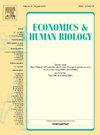Are preadolescent and adolescent physical growth failures related to poorer adolescent cognitive and socioemotional skills in Ethiopia, India, Peru, and Vietnam?
IF 1.8
3区 医学
Q2 ECONOMICS
引用次数: 0
Abstract
This study uses longitudinal data from Ethiopia, India, Peru, and Vietnam to assess the associations between adolescent skills and their physical growth in life-cycle periods that are overlapping or following puberty growth spurts. In place of total growth over a life-cycle period, our analysis uses conditional growth, which is the part of height change that is uncorrelated with height at the start of the period. The adolescents’ cognitive achievements are based on their test results in math, receptive vocabulary, and reading comprehension, and their socioemotional skills are based on their self-efficacy, self-esteem, and peer relations. The main findings include: (1) adolescent cognitive achievements are associated with preadolescence and early adolescence growth; (2) the association between cognitive skills and physical growth continues into late adolescence for boys in poor regions; (3) significant associations are found between adolescents’ socioemotional skills and their growth in preadolescence, adolescence or both; and (4) across adolescent groups by sex and poor versus nonpoor regions, growth between ages 12 and 15 is associated with their socioemotional skills. The findings of this study provide additional insights to support age-specific investments in the health and nutrition of preadolescents and adolescents.
在埃塞俄比亚、印度、秘鲁和越南,青春期前和青春期身体发育失败是否与较差的青少年认知和社会情感技能有关?
本研究使用了来自埃塞俄比亚、印度、秘鲁和越南的纵向数据,以评估青少年技能与他们在青春期生长高峰重叠或之后的生命周期中身体发育之间的关系。我们的分析使用的是条件增长,而不是整个生命周期的总增长,这是身高变化的一部分,与该时期开始时的身高无关。青少年的认知成就是基于他们在数学、接受性词汇和阅读理解方面的测试成绩,而他们的社会情感技能是基于他们的自我效能感、自尊和同伴关系。主要研究结果包括:(1)青少年认知成就与青春期前和青春期早期发育相关;(2)贫困地区男孩认知技能与身体发育的关系持续到青春期后期;(3)青少年的社会情绪技能与其青春期前、青春期或两者均有显著相关;(4)按性别和贫困地区与非贫困地区划分的青少年群体,12至15岁之间的成长与他们的社会情感技能有关。这项研究的结果为支持在青春期前和青少年的健康和营养方面进行针对年龄的投资提供了额外的见解。
本文章由计算机程序翻译,如有差异,请以英文原文为准。
求助全文
约1分钟内获得全文
求助全文
来源期刊

Economics & Human Biology
医学-公共卫生、环境卫生与职业卫生
CiteScore
4.50
自引率
12.00%
发文量
85
审稿时长
61 days
期刊介绍:
Economics and Human Biology is devoted to the exploration of the effect of socio-economic processes on human beings as biological organisms. Research covered in this (quarterly) interdisciplinary journal is not bound by temporal or geographic limitations.
 求助内容:
求助内容: 应助结果提醒方式:
应助结果提醒方式:


